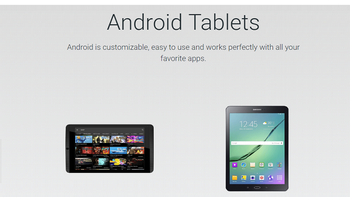Google removes tablet section from Android website (UPDATE X 2)

With a 6.4-inch Samsung Galaxy Note 9 expected to hit the market before September, the question is, who needs an Android tablet? The increasing size of the screens on newer high-end handsets is one of the reasons for declining tablet sales globally. In addition, tablet owners don't look to upgrade to a new slate every two to three years. With this background, Google has quietly removed the tablet section from the Android website. Since Google didn't unveil a reference tablet for Android P this year, it is a move that the company has foreshadowed.
UPDATE: Good news tablet fans. The tablet section has returned to the Android.com website.
UPDATE 2: Google is blaming the disappearance of the tablet section on a bug. A tweet from Hiroshi Lockheimer, Google SVP of platforms and ecosystems for Android, Chrome, Chrome OS and Play, says that a bug caused the tablet section to disappear while Google was in the process of updating the page. But one cynical Twitter subscriber noted that there was no update to the Tablet page as the slates pictured on it are "ancient."

Google executive explains why the Tablet section disappeared on the Android.com website
There was a time when Android tablets had their own version of the Android operating system, called Honeycomb (Android 3.0). The OS launched to much fanfare in January 2011, when the first Apple iPad wasn't even a year old. At the time, Motorola had introduced its first tablet called the Xoom, and it came to market with Honeycomb pre-installed. Nine months later, the Samsung Galaxy Note was unveiled, the first smartphone to carry a 5-inch screen. The device was launched in late October 2011, and the race to build handsets with larger and larger screens was on.
Without Google's support, we probably won't be seeing a new batch of Android powered slates from major manufacturers any time soon. According to IDC, 163.5 million tablets were shipped world-wide last year, a 6.5% decline from 2016's numbers. Apple still has the most popular tablet line, and Google is apparently giving up on Android versions of the device. Meanwhile, there is some talk that Google would like to see more manufacturers turn to Chrome OS to run their tablets. Since the latter supports Android apps, this is most likely the future of Google supported slates. Back in March, Acer introduced the Chromebook Tab 10, the first tablet to run on Chrome OS.
You can see what the tablet section on the Android site looked like before it was removed by checking out the image at the top of this article.













Things that are NOT allowed: